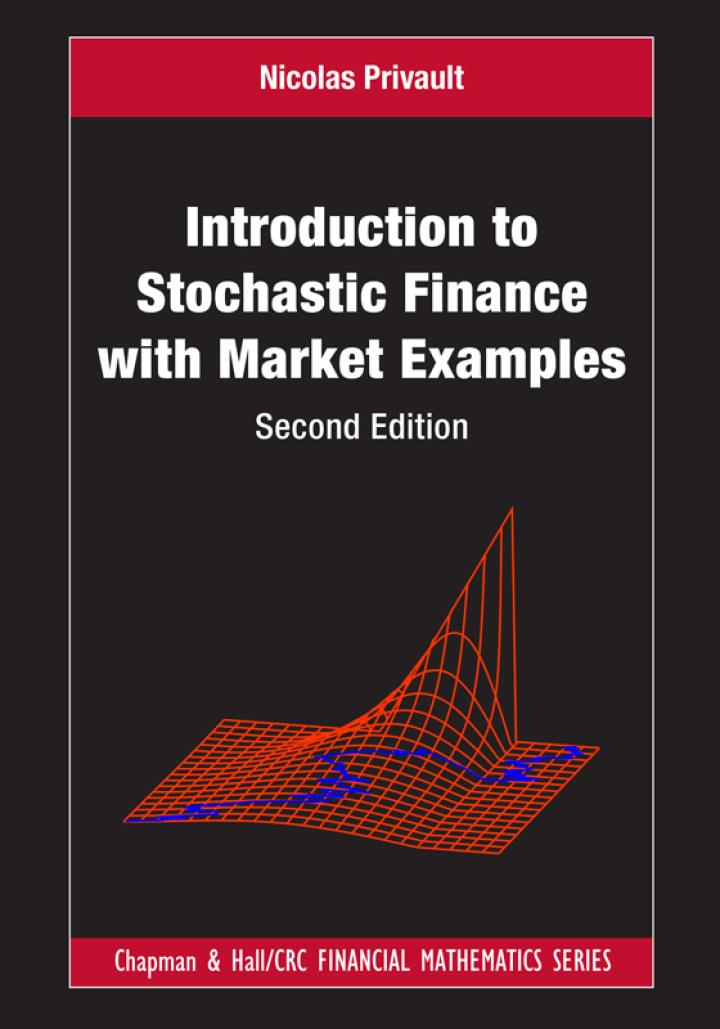Consider a risky asset priced [ S_{t}=S_{0} mathrm{e}^{sigma B_{t}+mu t-sigma^{2} t / 2}, quad text { i.e.
Question:
Consider a risky asset priced
\[
S_{t}=S_{0} \mathrm{e}^{\sigma B_{t}+\mu t-\sigma^{2} t / 2}, \quad \text { i.e. } \quad d S_{t}=\mu S_{t} d t+\sigma S_{t} d B_{t}, \quad t \geqslant 0
\]
a riskless asset valued \(A_{t}=A_{0} \mathrm{e}^{r t}\), and a self-financing portfolio allocation \(\left(\eta_{t}, \xi_{t}ight)_{t \in \mathbb{R}_{+}}\)with value
\[
V_{t}:=\eta_{t} A_{t}+\xi_{t} S_{t}, \quad t \geqslant 0
\]
a) Using the portfolio self-financing condition \(d V_{t}=\eta_{t} d A_{t}+\xi_{t} d S_{t}\), show that we have
\[
V_{T}=V_{t}+\int_{t}^{T}\left(r V_{s}+(\mu-r) \xi_{s} S_{s}ight) d s+\sigma \int_{t}^{T} \xi_{s} S_{s} d B_{s}
\]
b) Show that under the risk-neutral probability measure \(\mathbb{P}^{*}\) the portfolio value \(V_{t}\) satisfies the Backward Stochastic Differential Equation (BSDE)
\[
\begin{equation*}
V_{t}=V_{T}-\int_{t}^{T} r V_{s} d s-\int_{t}^{T} \pi_{s} d \widehat{B}_{s} \tag{7.48}
\end{equation*}
\]
where \(\pi_{t}:=\sigma \xi_{t} S_{t}\) is the risky amount invested on the asset \(S_{t}\), multiplied by \(\sigma\), and \(\left(\widehat{B}_{t}ight)_{t \in \mathbb{R}_{+}}\)is a standard Brownian motion under \(\mathbb{P}^{*}\).
Hint: the Girsanov Theorem 7.3 states that
\[
\widehat{B}_{t}:=B_{t}+\frac{(\mu-r) t}{\sigma}, \quad t \geqslant 0
\]
is a standard Brownian motion under \(\mathbb{P}^{*}\).
c) Show that under the risk-neutral probability measure \(\mathbb{P}^{*}\), the discounted portfolio value \(\widetilde{V}_{t}:=\mathrm{e}^{-r t} V_{t}\) can be rewritten as
\[
\begin{equation*}
\tilde{V}_{T}=\tilde{V}_{0}+\int_{0}^{T} \mathrm{e}^{-r s} \pi_{s} d \widehat{B}_{s} \tag{7.49}
\end{equation*}
\]
d) Express \(d v\left(t, S_{t}ight)\) by the Itô formula, where \(v(t, x)\) is a \(\mathcal{C}^{2}\) function of \(t\) and \(x\).
e) Consider now a more general BSDE of the form
\[
\begin{equation*}
V_{t}=V_{T}-\int_{t}^{T} f\left(s, S_{s}, V_{s}, \pi_{s}ight) d s-\int_{t}^{T} \pi_{s} d B_{s} \tag{7.50}
\end{equation*}
\]
with terminal condition \(V_{T}=g\left(S_{T}ight)\). By matching (7.50) to the Itô formula of Question (d), find the PDE satisfied by the function \(v(t, x)\) defined as \(V_{t}=v\left(t, S_{t}ight)\).
f) Show that when
\[
f(t, x, v, z)=r v+\frac{\mu-r}{\sigma} z
\]
the PDE of Question (e) recovers the standard Black-Scholes PDE.
g) Assuming again \(f(t, x, v, z)=r v+\frac{\mu-r}{\sigma} z\) and taking the terminal condition
\[
V_{T}=\left(S_{0} \mathrm{e}^{\sigma B_{T}+\left(\mu-\sigma^{2} / 2ight) T}-Kight)^{+},
\]
give the process \(\left(\pi_{t}ight)_{t \in[0, T]}\) appearing in the stochastic integral representation (7.49) of the discounted claim payoff \(\mathrm{e}^{-r T}\left(S_{0} \mathrm{e}^{\sigma B_{T}+\left(\mu-\sigma^{2} / 2ight) T}-Kight)^{+}\).*
h) From now on we assume that short selling is penalized* at a rate \(\gamma>0\), i.e. \(\gamma S_{t}\left|\xi_{t}ight| d t\) is subtracted from the portfolio value change \(d V_{t}\) whenever \(\xi_{t}<0\) over the time interval \([t, t+d t]\). Rewrite the self-financing condition using \(\left(\xi_{t}ight)^{-}:=-\min \left(\xi_{t}, 0ight)\).
i) Find the BSDE of the form (7.50) satisfied by \(\left(V_{t}ight)_{t \in \mathbb{R}_{+}}\), and the corresponding function \(f(t, x, v, z)\).
j) Under the above penalty on short selling, find the PDE satisfied by the function \(u(t, x)\) when the portfolio value \(V_{t}\) is given as \(V_{t}=u\left(t, S_{t}ight)\).
k) Differential interest rate. Assume that one can borrow only at a rate \(R\) which is higher \({ }^{\dagger}\) than the risk-free interest rate \(r>0\), i.e. we have
\[
d V_{t}=R \eta_{t} A_{t} d t+\xi_{t} d S_{t}
\]
when \(\eta_{t}<0\), and
\[
d V_{t}=r \eta_{t} A_{t} d t+\xi_{t} d S_{t}
\]
when \(\eta_{t}>0\). Find the PDE satisfied by the function \(u(t, x)\) when the portfolio value \(V_{t}\) is given as \(V_{t}=u\left(t, S_{t}ight)\).
1) Assume that the portfolio differential reads
\[
d V_{t}=\eta_{t} d A_{t}+\xi_{t} d S_{t}-d U_{t}
\]
where \(\left(U_{t}ight)_{t \in \mathbb{R}_{+}}\)is a non-decreasing process. Show that the corresponding portfolio strategy \(\left(\xi_{t}ight)_{t \in \mathbb{R}_{+}}\)is superhedging the claim payoff \(V_{T}=C\).
Step by Step Answer:

Introduction To Stochastic Finance With Market Examples
ISBN: 9781032288277
2nd Edition
Authors: Nicolas Privault





